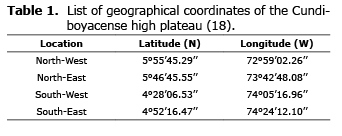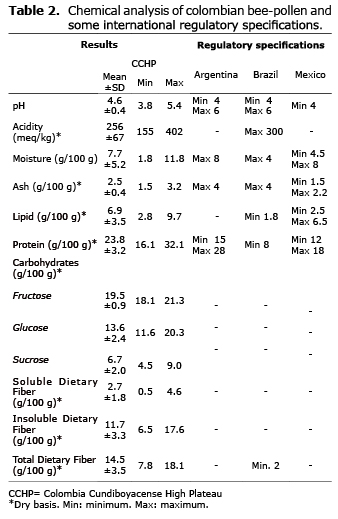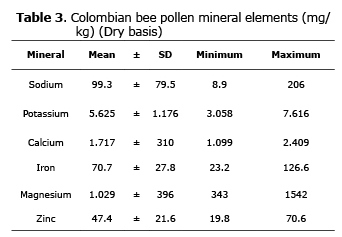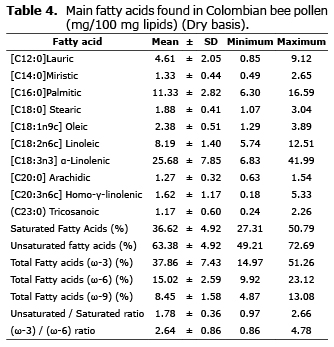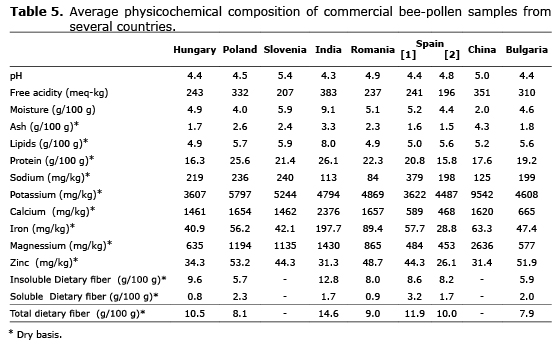Services on Demand
Journal
Article
Indicators
-
 Cited by SciELO
Cited by SciELO -
 Access statistics
Access statistics
Related links
-
 Cited by Google
Cited by Google -
 Similars in
SciELO
Similars in
SciELO -
 Similars in Google
Similars in Google
Share
Revista MVZ Córdoba
Print version ISSN 0122-0268
Rev.MVZ Cordoba vol.19 no.1 Córdoba Jan./Apr. 2014
ORIGINAL
Evaluation of the physicochemical and functional properties of Colombian bee pollen
Evaluación de las propiedades fisicoquímicas y funcionales del polen apícola colombiano
Carlos Fuenmayor B,1,2 Ph.D, Carlos Zuluaga D,1 M.Sc, Consuelo Díaz M,1 Ph.D, Marta Quicazán de C,1* Ph.D, María Cosio,2 Ph.D, Saverio Mannino,2 Ph.D.
1Universidad Nacional de Colombia, Instituto de Ciencia y Tecnología de Alimentos - ICTA, Ciudad Universitaria, Av. Cra. 30 # 45-03 Ed. 500C, 111321. Bogotá, Colombia.
2Universidad de Milán, Departamento de Ciencias Alimentarias, Ambientales y Nutricionales, Via Mangiagalli 25, 20133 Milán, Italia.
*Correspondence: mcquicazand@unal.edu.co
Received: February 2013; Accepted: September 2013.
ABSTRACT
Objective. To establish current knowledge about Colombian bee-pollen from a point of view nutritional and functional, contributing towards creating national technical standards and the identification of chemical differentiation factors for further researches. Material and methods. One hundred ninety-six samples of dried bee pollen were collected in the center region of Colombia known as Cundi-boyacense high plateau, where nearly 90% of total bee pollen production is concentrated in this country. Performed physicochemical analyses in this study were: moisture, pH, acidity, ash, carbohydrates, lipids, proteins, dietary fiber, fatty acid profile and mineral elements. Results. Bee pollen from this region had 7.7±5.2 g/100 g moisture content, and a following centesimal composition based on dry matter: ashes 2.5±0.4 g; lipids 6.90±3.5 g; proteins 23.8±3.2 g and total dietary fiber 14.5±3.5 g. The most abundant fatty acids were α-linolenic, palmitic and linoleic. Carbohydrates were the main components and fructose and glucose the most concentrated sugars. The predominant minerals assessed here were potassium, calcium and magnesium. The results were also discussed in terms of the characteristics found in Colombian bee-pollen in comparison to international regulations and findings for other varieties of commercial bee-pollen from eight different countries. Conclusions. The results found in this study suggest that bee-pollen may be used as a dietary supplement and agree with bibliographical reports and international regulations. Such characterization will enable to be proposed technical standards in line with Colombian bee-pollen properties and it is expected to improve marketing and production chain conditions.
Key words: Apis mellifera, dietary supplements food composition, food quality, physicochemical analysis (Source: DeCS).
RESUMEN
Objetivos. Generar conocimiento actualizado sobre el polen colombiano desde un punto de vista nutricional y funcional, contribuyendo a la creación de estándares técnicos nacionales y la identificación de factores químicos de diferenciación para futuras investigaciones. Materiales y métodos. Ciento noventa y seis muestras de polen seco fueron recolectadas en la región central de Colombia conocida como el altiplano cundiboyacense, donde se concentra cerca del 90% de la producción total en este país. Los análisis fisicoquímicos realizados en este estudio fueron: humedad, pH, acidez, cenizas, carbohidratos, lípidos, proteínas, fibra dietaria, perfil de ácidos grasos y minerales. Resultados. El polen de esta región tuvo un contenido de humedad de 7.7±5.2 g/100 g y una composición centesimal basada en materia seca: cenizas 2.5±0.4 g; lípidos 6.90±3.5 g; proteínas 23.8±3.2 g y fibra dietaria total 14.5±3.5 g. Los ácidos grasos más abundantes fueron α-linolénico, palmítico y linoleico. Los carbohidratos fueron los componentes principales con fructosa y glucosa siendo los azúcares más concentrados. Los minerales predominantes evaluados fueron potasio, calcio y magnesio. Los resultados también fueron discutidos en términos de las características encontradas en el polen colombiano en comparación a normatividades internacionales y hallazgos para otras variedades de polen comercial de ocho países diferentes. Conclusiones. Los resultados encontrados en este estudio sugieren que el polen apícola puede ser utilizado como suplemento dietario y es coherente con los reportes bibliográficos y normativas internacionales. Tal caracterización permitirá proponer estándares técnicos de acuerdo a las propiedades del polen colombiano y se espera que se mejore la comercialización y las condiciones de la cadena de producción.
Palabras clave: Apis mellifera, análisis fisicoquímico, composición de alimentos y suplementos dietarios, calidad de alimentos (Fuente: DeCS).
INTRODUCTION
Bee pollen, also regarded, as apicultural pollen, corbicular pollen, or bee-collected pollen, is the main source of protein for bee colonies. Worker bees transport this resource from flowers into the hive by carrying it on their hind legs as pellets that they form with movements of their front legs using combs, hairs and salivary secretions (1). Once in the hive, bees store pollen in cells where it undergoes processes similar to ensiling, prior to being eaten by pups and adults; it is then referred to as bee bread (2). Proper hive management promotes additional pollen collection aimed at marketing it for human consumption, since it can be considered as food or food additive due to its content of a wide range of nutrients (1,3-5). It also represents a functional dietary supplement, especially because of its antioxidant and antimicrobial activities, its micronutrients composition, its fatty acid profile and its therapeutic or disease-preventing functions (6-9).
Beekeepers thus locate traps in the hive entrance through which the worker bees cannot pass easily with both legs carrying pollen pellet so they are forced to drop them onto trays which are periodically withdrawn and from which pollen pellets are removed and subjected to further processing for prolonging shelf-life, usually drying processes.
Contemporary pollen consumption and marketing has recently achieved certain diffusion; however, this product went practically unrecognized as a food product for a long time, except by vegetarian or naturist consumers (10). At present there are only few countries (i.e. Spain, China, Hungary, Argentina and Brazil) where pollen production is economically significant; even so, the pollen consumer market has strengthened during the last couple of decades (11). Countries such as Brazil, Argentina, Switzerland, Spain and Mexico have established official quality standards and recognized pollen as a food product (12).
Physicochemical characteristics of bee pollen depend on its botanical origin (1). Although some work on the nutritional composition of bee pollen from countries like Brazil (1), Spain (4), Australia (13), Argentina (14), Algeria (15), China (16) and South Africa (3) can be found, no significant study has been published about Colombian bee pollen even though production in Colombia has been constantly increasing over the last decade mainly due to exceptional climatic conditions (17).
The objective of this research was aimed at characterizing Colombian bee pollen, coming from the colombian cundi-boyacense high plateau, from a nutritional and functional point of view, to contribute towards establishing national technical standards and official regulation, thereby leading to establishing origin-denomination labeling. The obtained results are compared to international normativity and referenced bibliography, and also, to samples of commercial bee-pollen from several countries.
MATERIALS AND METHODS
Type of study and samples. This research work has been made in the context of the project Strategies for establishing Designation of Origin of bee products in Colombia, funded by the Ministry of Agricultural and Rural Development of Colombia, which involved the beekeepers' associations of the Cundi-boyacense high plateau. In total, 196 bee-pollen samples (Apis mellifera) were collected. These samples were dried and impurities were removed as beekeepers usually do (2-hour drying using forced-air ovens, with initial air temperature below 43°C, followed by sieving and a density-gradient process for removing impurities). The samples were collected during 2008 and 2011.
In addition, nine samples of commercial bee-pollen from India, China, Romania, Spain, Bulgaria, Hungary and Poland were provided by manufacturers and marketers houses of pollen from the respective countries during the trade fair of the 41st World Congress of Apiculture - Apimondia, September 15th to 20th, 2009, in Montpellier, France.
All samples were brought to laboratory in the usual commercial presentation where they were ground using a 1.5 mm sieve and kept at 4°C in the dark until being analyzed.
Coordinates of the study site. Geographical coordinates of the colombian Cundi-boyacense high plateau according to IGAC-ORSTOM (18) are related in table 1.
Laboratory methods
pH and acidity. 2.5 g of previously weighed sample was mixed with CO2-free water and titration was started with NaOH 0.05 N until pH 8.5. pH is calculated by using a potentiometer previously to titration (10).
Moisture. 3 g of sample was weighed and heated at 65°C for 24 h. Moisture content was obtained by difference (10).
Lipids. Lipids were determined by the Soxhlet method in which they were extracted from the food matrix by solvent drag; this latter is then separated from lipids by heating -AOAC 920.39- (19).
Protein. It was determined following the Kjehldahl method with the Winkler variation. Boric acid was used for quantifying nitrogen content in the sample, applying an N x 6.25 conversion factor -AOAC 984.13- (19).
Ash and minerals. Ash determination was made through gravimetry after incineration in an oven at 600°C until constant weight. Minerals were determined by using the ash so obtained after digestion and dilution stages. An AA 240 atomic absorption spectrometer (Varian Inc, USA) was used for taking mineral measurements according to the following wavelengths: Na: 599 nm, Mg: 285nm, K: 766.5 nm, Ca: 422.7 nm, Zn: 213.9 nm and Fe: 248.3 nm -AOAC 968.08- (19).
Dietary fiber. Dietary fiber was determined by using dried and degreased pollen, with an enzymatic treatment of α-amylase, protease and amyloglucosidase. A posterior filtration stage allows obtaining the soluble dietary fiber; meanwhile, insoluble dietary fiber is obtained by precipitation with ethanol -AOAC 985.29- (19,20).
Sugars. HPLC was used for assessing simple carbohydrates. 40 ml of ultrapure sterilized water were added to 5 g of the previously weighed samples to extract sugars. The obtained solution was injected into the chromatograph (Jasco PU-980 pump system), by using a 30 cm x 0.78 cm Varian column (MetaCarb Ca Plus A5205). Degasified water was used as mobile phase at 0.5 ml/min flow rate, and temperature was set at 80°C (Jasco, CO-2065 Plus oven). A refraction index detector (Jasco, RI-203 Plus) was used for detecting fructose, glucose and sucrose content. This procedure was adapted from the methodology proposed by method -AOAC 979.23- (19).
Fatty acids profile. Fatty acid composition was determined by gas chromatography, according to AOAC 969.33 (19). The extracts were made by using petroleum ether as solvent and underwent derivatization with sodium methoxide until an emulsion was obtained. The methylic esters produced were measured by chromatography in an Agilent 7890A system with a 30 m x 0.25 mm x 0.25 µm column (OSGE BPX 70). Injector temperature was set at 210°C, detector temperature was 220°C and column temperature was maintained at 180°C. Carrier gas (He) flow rate was 1 to 1.5 ml/min. Fatty acid identification and quantification was done by comparing retention times with standards injected the same day.
Statistical analysis. Means and standard deviations were calculated by using the software Microsoft® Excel.
RESULTS
The bee pollen samples for this study were taken from the most important region for this apicultural activity in Colombia, covering most commercially available varieties of this product in the country. This region is the Cundiboyacense high plateau which is located at an altitude higher than 2500 m.a.s.l., on the central part of the colombian eastern Andes. It consists of flat and high lands between the Cundinamarca and Boyacá departments, having a 15°C mean temperature which can range from 0 to 24°C. It is characterized by, being very fertile for a wide variety of plant species and having alternating flowering seasons for several native plants, shrubs and economically important crops throughout the whole year. The Cundiboyacense high plateau has an Andes orobiome, characterized by the presence of mixed agricultural areas, pasture for dairy production, shrub land and damp moor shaving endemic vegetation in the highest parts. Most beekeepers from this region have formed associations and cooperatives, which, together with increasing demand, have enhanced this activity, stimulating many beekeepers to focus exclusively on pollen production.
In this region a large number of plant species can be found simultaneously providing pollen for Apis mellifera bees, causing the samples to display a multiplicity of pellet colors and the practical impossibility of having monofloral bee pollen. Although in this study it was not performed a palynological characterization, Nates-Parra et al (21) in a previous report revealed that Melastomatacea and Fabaceae (including its three sub-families), Asteracea, Myrtaceae, Euphorbiacea were the most important plant families providing pollen in the Cundiboyacense high plateau.
For the physicochemical results of colombian bee-pollen, the mean and standard deviation were calculated for all data. Table 2 presents average bee-pollen composition as well as the data of Brazilian, Mexican and Argentinean regulations. On the other hand, tables 3 and 4 show results for average mineral and fatty acid composition, respectively.
On the other hand, commercial bee-pollen from eight countries was analyzed to make a comparison of its physicochemical properties with respect to colombian bee product, which they are presented in table 5.
DISCUSSION
Acidity and pH. The pH of colombian bee-pollen varied between 3.8 and 5.4 and presented a 4.6 (±0.4) general mean value; acidity ranged from 155 to 402 meq/kg with 256 (±67) meq/kg as mean value. These two parameters were inversely correlated, as expected. Except for a few works usually dealing with the biochemical changes that pollen suffers inside a bee hive when becoming beebread (22), bee pollen acidity has rarely been assessed. pH, on the other hand, has been used as quality indicator, since it is an easy-to-assess parameter. An elevated acidity or low pH can result from undesirable microbial activity (23). Argentinean regulation establishes a pH range from 4 to 6, which, according to the results, seems to be accurate for colombian pollen as well. In comparison with bee-pollen from other countries, shown in table 5, it can be found that pH and acidity values are similar to colombian pollen. Particularly, acidity of Poland, Indian, Chinese and Bulgarian bee-pollens are higher than 300 meq/kg, and those would not fulfill the brazilian normativity.
Moisture. Beekeepers reduce bee pollen moisture content by drying (from initial values ranging from 18% to 34% on the Cundiboyacense high plateau) (10) to reduce water activity and so prevent microbial deterioration. Colombian bee-pollen varied from 1.8 to 11.8 g/100 g in the present study and had 7.7 (± 5.2) g/100 g mean value. Most samples (93%) met the argentinean standard of 8% as maximum allowable moisture content but only 19% of them complied with brazilian regulations stating a maximum of 4%. Bee pollen below ~6 g/100 g is in the acceptable range for storage stability, having into account that also a moisture content lower than 4% may induce to rancidity reactions (11). Moisture content of international bee-pollen ranged from 2.0 (China) to 9.1 (India); it is clear that bee-pollen drying techniques are poorly studied and standardized, that is why it can be found considerable differences in the water content of bee-pollen worldwide.
Protein. Bee-pollen protein content is one of its most regarded nutritional features; this ranged from 16.1 to 32.1 g/100g (dry basis) evaluated by using factor N x 6.25, having a 23.8 (±3.2) g/100 gmean. These results were similar to those obtained by Szczesna (24) for pollen from Poland, by Estevinho et al (25) for pollen collected in Portugal and by Almeida-Muradian et al (1) for brazilian pollen. There were differences with spanish pollen protein content as reported by González-Martín et al (4), where it was lower; the differences found in the total amount of protein were due to their botanical origin (26). Brazilian regulations for bee pollen protein content set an 8% minimum (dry weight) while argentinean regulations state a range from 15% to 28% (dry weight); all Cundiboyacense high plateau samples analyzed were above the minimum for both the foregoing and 11% of them were above the maximum argentinean standard. In comparison to international bee-pollen, colombian had one of the greatest proteins content, similar to bee-pollen from Romania (22.3 g/100 g) and only below of Poland (25.6 g/100 g) and India (26.1 g/100 g).
Fiber. IDF varied from 6.5 to 17.6 g/100 g, having an 11.7 (± 3.3) g/100 g mean. On the other hand SDF varied from 0.5 to 4.6 g/100 g, having a 2.7 (± 1.8) g/100 g mean (dry basis). The amount of SDF was considerably high compared to most manufactured products. The mean for total dietary fiber was of 14.5 g/100 g. Among analyzed international bee-pollen, India had the greatest IDF content (12.8 g/100 g), meanwhile other analyzed international products ranged from 5.7 to 9.6. One sample from Spain had the greatest content of SDF (3.2 g/100g), a notorious high value compared to other countries (ranges from 0.8 to 2.3 g/100g). It can be seen that the proportion of soluble and insoluble dietary fiber of colombian bee-pollen constitutes another functionality factor, having even higher contents than similar products from other regions.
Carbohydrates. Three main sugars were identified and quantified; fructose was the most abundant (19.45±0.92 g/100 g dry weight), followed by glucose (13.58±2.35 g/100 g) and sucrose (6.68±2.03 g/100 g). F/G ratio varied between 1.20 and 1.61. The existing regulation in different countries does not consider minimum or maximum limits for carbohydrate content in pollen; however, in comparison to data obtained for Qian et al (5), for chinese bee pollen, results differ noticeably, especially regarding sucrose concentration which has been reported as being considerably higher.
Lipids. Total lipid content was highly variable and ranged from 2.8 to 9.7 g/100 g (mean 6.9 (±3.5) g/100 g). Pollens from this region met the minimum 1.8% (dry weight) total lipids specified in brazilian and mexican regulations. The content of lipids is highly variable and dependent on the amount of fatty acids, carotenes and vitamins present in pollen. Mean values were similar to those found in pollen varieties from other countries, which ranged from 4.9 to 8.0 g/100 g, with pollen from India having the highest content. Nevertheless, it is important to note that the appreciable standard deviation obtained for colombian bee-pollen is due to the diversity of botanical origin of pollens from this region.
Fatty acid profile. The fatty acid profile was analyzed for pollens from Cundiboyacense high-plateau. α-linolenic [C18:3n3] was found to be the most important fatty acid (25.68 mg/100 mg mean lipid concentration equal to 39.2% of fatty acids found) followed by palmitic [C16:0] (11.33 mg/100 mg of lipids), linoleic [C18:2n6c] (8.19 mg/100 mg of lipids), lauric [C12:0] (4.61 mg/100 mg of lipids), oleic [C18:1n9c] (2.38 mg/100 mg of lipids), stearic [C18:0], cis-8,11,14-eicosatrienoic [C20:3n6], miristic [C14:0] and tricosanoic [C23:0]. The unsaturated/saturated fatty acid ratio was 1.78; ratios greater than 1 have been previously found in bee pollen (3,6,25), variations being due to botanical origin. The lipid fraction may also contain other fatty acids, pigments, waxes, sterols, liposoluble vitamins, heavy alcohols and hydrocarbons (3).
Ash and minerals. Mean ash content found for colombian bee-pollen was 2.5 (±0.4) g/100 g (dry basis) ranging from 1.5 to 3.2 g/100 g. These results agreed with previous findings (1,13); all samples met both argentinean and brazilian standards establishing a maximum 4% (dry weight). A comparison with international bee-pollen showed similar values for ash content ranging between 1.5 and 3.3 g/100 g, except for China with 4.3 g/100 g.
On the other hand, six minerals were assessed (Table 3), potassium being the most concentrated, followed in decreasing order by calcium, magnesium, sodium, iron and zinc. The results agreed with other findings (1,13). Such mineral profile supports the idea of pollen being a nutritional supplement. Bee-pollen from other countries has shown a great diversity; potassium and magnesium content ranged from 3607 to 9542 mg/kg and 453 to 2636 mg/kg, respectively, with China having the highest content in both cases; this would explain the unusual high value for ash content. In calcium and iron, values ranged from 468 to 2376 mg/kg and 28.8 to 197.7 mg/kg, respectively, with India having the highest content in both cases. For sodium and zinc, the obtained values have not had a considerable variability among countries, ranging from 84 to 379 mg/kg and 26.1 to 53.2 mg/kg, respectively. Particularly, Colombian bee-pollen showed a considerable high value for potassium, calcium and iron content, and also, a low value for sodium.
As conclusions, physicochemical and functional characteristics of pollens from the Cundi-Boyacense high plateau could play an important role for quality control of this product and would satisfy international requirements, except for moisture content, where it is necessary to improve drying conditions to obtain a more suitable product. The particularities of colombian pollen composition demand that local standards become defined; the data presented here would thus provide a suitable basis for such work.
Particularly, high levels of minerals were found in analysis compared to several reports and analyzed bee-pollen from several countries. The high potassium, protein, dietary fiber and lipids levels indicated the possibility of using pollen as a dietary supplement. Further analysis focused on bioactive components and properties and characterizing the volatile fraction and sensory characteristics are highly recommended for fully characterizing colombian bee pollens and differentiating them locally and from other varieties from around the world. It is expected that this work would be an important tool for cataloguing and recognizing colombian pollen as being a beneficial source of natural nutrients.
Acknowledgments
The authors thank the colombian Ministry of Agriculture and Rural Development, the colombian Science, Technology and Innovation Department (COLCIENCIAS), and the following beekeeping associations: Asociación de Apicultores de Boyacá (ASOAPIBOY), the Asociación de Apicultores de la región del Sumapaz (ASOAPIS), the Asociación de Apicultores Conservacionistas de la Sierra Nevada de Santa Marta (APISIERRA), the Asociación Apícola Comunera (ASOAPICOM), Apicultura Los Cerezos and Apiarios Los Cítricos.
REFERENCES
1. Almeida-Muradian L, Pamplona L, Coimbra S, Barth O. Chemical composition and botanical evaluation of dried bee pollen pellets. J Food Compos Anal 2005; 18(1):105-111. [ Links ]
2. Del Risco C, Pérez A, Álvarez V, Rodríguez G, Leiva V, Puig Y, et al. Bacterias ácido-lácticas para ensilar polen apícola. Revista CENIC. Ciencias Biológicas 2012; 43(1):17-21. [ Links ]
3. Human H, Nicolson S. Nutritional content of fresh, bee-collected and stored pollen of Aloe geatheadii va. davyana (Asphodelaceae). Phytochemistry 2006; 67:1486-1492. [ Links ]
4. Gonzalez-Martin I, Hernandez-Hierro J, Barros-Ferreiro N, Cordon C, Garcia-Villanova R. Use of NIRS technology with a remote reflectance fibre-optic probe for predicting major components in bee pollen. Talanta 2007; 72:998-1003. [ Links ]
5. Qian WL, Khan Z, Watson DG, Fearnley J. Analysis of sugars in bee pollen and propolis by ligand exchange chromatography in combination with pulsed amperometric detection and mass spectrometry. J Food Compos Anal 2008; 21(1):78-83. [ Links ]
6. Xu X, Dong J, Mu X, Sun L. Supercritical CO2 extraction of oil, carotenoids, squalene and sterols from lotus (Nelumbo nucífera Gaertn) bee pollen. Food Bioprod Process 2011; 89(1):47-52. [ Links ]
7. Xu L, Sun I, Dong L, Zhang H. Breaking the cells of rape bee pollen and consecutive extraction of functional oil with supercritical carbon dioxide. Innovat Food Sci Emerg Tech 2009; 10:42-46. [ Links ]
8. Pinto B, Caciagli F, Riccio E, Reali D, Šaric A, Balog T, et al. Antiestrogenic and antigenotoxic activity of bee pollen from Cystus incanus and Salix alba as evaluated by the yeast estrogen screen and the micronucleus assay in human lymphocytes. Eur J Med Chem 2010; 45(9):4122-4128. [ Links ]
9. Mãrghitas LA, Stanciu OG, Dezmirean DS, Bobis O, Popescu O, Bogdanov S, et al. In vitro antioxidant capacity of honeybee-collected pollen of selected floral origin harvested from Romania. Food Chem 2009; 115(3):878-883. [ Links ]
10. Diaz C, Zuluaga C, Fuenmayor C, Martinez T. Special features of pollen production in Colombia. 41st World Congress of Apiculture. Montpellier, France; Apimondia: 2009. [ Links ]
11. Campos M, Bogdanov S, Almeida-Muradian L, Szczesna T, Mancebo Y, Frigerio C, et al. Pollen composition and standardisation of analytical methods. J Apicult Res 2008; 47(2):156-163. [ Links ]
12. Bogdanov S. The Bee Pollen Book. Bulgaria: Bee Product Science; 2011. [ Links ]
13. Somerville D, Nicol H. Mineral content of honeybee-collected pollen from sothern New South Wales. Aust J Exp Agr 2002; 42(8):1131-1136. [ Links ]
14. Baldi B. Composición bromatológica del polen argentino. Ciencia, docencia y tecnología. Argentina: Universidad Nacional de Entre Ríos; 2004. [ Links ]
15. Rebiai A, Lanez T. Chemical composition and antioxidant activity of Apis mellifera bee pollen from northwest Algeria. J Fund Appl Sci 2012; 4(2):26-35. [ Links ]
16. Yang K, Wu D, Ye X, Liu D, Chen J, Sun P. Characterization of Chemical Composition of Bee Pollen in China. J Agr Food Chem 2013; 61:708-718. [ Links ]
17. Martínez T. Diagnóstico de la actividad apícola y de la crianza de abejas en Colombia. Colombia: Ministerio de Agricultura y Desarrollo Rural - Dirección de Cadenas Productivas. Instituto Intermaericano de Cooperación para la Agricultura; 2006. [ Links ]
18. IGAC-ORSTOM. Estudio regional integrado del Altiplano Cundiboyacense: estudio general de suelos. Bogotá, Colombia; 1984. [ Links ]
19. AOAC. Official Methods of Analysis of AOAC International. Association Official Analytical Chemists; 2005. [ Links ]
20. Díaz C, Zuluaga C, Morales C, Quicazán M. Determinación de fibra dietaria en polen apícola colombiano. Vitae 2012; 19(S1):454-456. [ Links ]
21. Nates-Parra G, Montoya P, Obregón D, Ramírez N, Solarte V, Chamorro F. La melisopalinología como herramienta para la diferenciación por origen botánico de productos de abejas en Colombia. Sincelejo, Colombia: Encuentro Nacional de Apicultura; 2010. [ Links ]
22. Čeksteryte V, Račys J, Kaškoniené V, Venskutonis P. Fatty acid composition in beebread. Biologija 2008; 54(4):253-257. [ Links ]
23. Fuenmayor C, Quicazán M, Torres A, Rubio A. A beebread-inspired functional dietary supplement by means of solid state fermentation of honeybee-collected pollen with probiotic. Montpellier, France: Apimondia; 2009. [ Links ]
24. Szczesna T. Protein content and amino acid composition of bee-collected pollen from selected botanical origins. J Apic Sci 2006; 50(2):81-90. [ Links ]
25. Estevinho LM, Rodrigues S, Pereira AP, Feás X. Portuguese bee pollen: palynological study, nutritional and microbiological evaluation. Int J Food Sci Technol 2012; 47(2):429-435. [ Links ]
26. Almaraz-Abarca N, Campos M, Ávila-Reyes J, Naranjo-Jiménez N, Herrera-Corral J, González-Valdez L. Variability of antioxidant activity among honeybee-collected pollen of different botanical origin. Interciencia 2004; 29(10):1-12. [ Links ]













